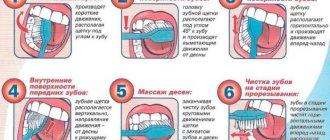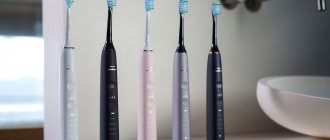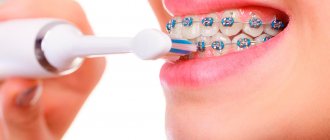Is it possible to brush your teeth with salt?
Salt can be used to clean teeth. It has no contraindications and, when used correctly, benefits the body.
Note! This cheap, natural product has been used to clean teeth since the 17th century.
Plaque is eliminated through the action of abrasive particles. They also help whiten tooth enamel.
An important advantage of such a folk remedy is the absence of an allergic reaction , since it is completely natural.
Cleaning the mouth with salt is a good method for preventing the development of caries and periodontal disease .
The solution can be used as an additional remedy for the treatment of diseases of the oral cavity .
The number and interval of cleanings depends on the sensitivity of the mucous membrane and enamel. The transition to salt cleansing should be done gradually.
At first, it is recommended to use this product for oral hygiene once a week.
Positive traits
Hygienic cleaning of dental units is a useful procedure that allows you to achieve strengthening and healing of weakened teeth. In addition, this procedure has a number of positive qualities:
- Has a positive effect on all tissues of the oral cavity;
- It is accessible and low cost compared to other whitening products;
- When ingested, it does not have a harmful effect, unlike other teeth cleaning products;
- Does not cause side effects;
- When used, it reduces unpleasant odor from the mouth;
- Reduces the risk of such unpleasant pathological processes as periodontal disease, periodontitis, and carious lesions;
- All stores always sell only natural table salt without various impurities
The main positive qualities that distinguish cleansing with salt from other methods are accessibility, because you can buy salt in any store, and harmlessness, because Getting salt into your body will not harm your health.
What is the benefit of such cleaning?
What's the benefit? Salt perfectly eliminates bad breath, cleanses enamel and fights germs. Due to the presence of minerals, teeth are cared for.
Sea salt contains:
- iodine;
- calcium;
- magnesium; fluorine;
- phosphorus.
These same components are present in regular toothpaste, but in salt they are natural.
This product
helps fight tooth decay , which occurs due to pH imbalance and bacteria.
After salt cleaning, the acidity level is normalized and the pH becomes more balanced.
The product has natural antibacterial properties , which are necessary for maintaining oral hygiene.
The positive effect of salt cleansing is whitening. This cleaning method allows you to maintain the natural color of the enamel . Although the effect of such whitening is minimal.
Many dentists are quite skeptical about using such a product as a replacement for the usual toothpaste. However, they do not deny the benefits of salt cleansing.
Enamel demineralization
The enamel is 97% composed of hydroxyapatite crystals, a small amount of water (2–3%) and organic substances (1–2%). Over the course of a lifetime, it can wear out and break down for various reasons.
Demineralization is a process in which enamel loses useful minerals (primarily calcium), on which its integrity and strength depend.
Demineralization has two main causes.
- Poor oral hygiene, in which bacteria multiply and produce acid that destroys enamel.
- Excess carbohydrates in the diet are a breeding ground for bacteria.
At first, changes in the condition of the enamel are not noticeable, but if plaque is not removed in time, whitish spots appear (early stage of caries), and then full-fledged caries. Then just go to the dentist.
At the white spot stage, caries can still be prevented. To do this, you need to saturate the enamel with minerals, which will increase resistance to acids. You can strengthen your enamel both at home and in the dentist's office.
How effective is this method?
After a week of using salt to cleanse the mouth, you can notice the first result .
Keep in mind! The effect of use is the following changes:
- gums stop bleeding;
- the enamel becomes a little lighter ;
- bad breath disappears .
Salt is a good antiseptic, so it can be used to prepare a rinse solution.
Despite the fact that this cleaning method is quite effective, you should consult a specialist before using it, as this procedure has its drawbacks.
Sweets
The main “enemies” of teeth are chewing candies and caramel. Pieces of toffee or other chewing candies can get stuck in the spaces between teeth, contacting the enamel for a long time, causing accelerated growth of bacteria. Caramel changes the composition of saliva if it is absorbed; it can cause tooth decay, chips, cracks if it is chewed.
Dried fruits are considered harmful sweets. They contain a lot of sugar, stick to teeth, and get stuck in the spaces between teeth.
The exception is dark chocolate, which is considered beneficial for teeth due to the content of polyphenols and flavonoids. They have antibacterial properties and slow down plaque formation.
What's the harm?
If you do not follow the cleaning technology, you can harm your tooth enamel.
You should know! If you press too hard on your toothbrush, you can damage the enamel and cause pain in your gums.
Frequent salt cleansing can lead to thinning of the top layer of teeth.
If tooth enamel is damaged, brushing your teeth with salt or salt-based paste can cause pain.
Is it possible to remove tartar at home?
On the Internet and in printed publications you can find many recipes for removing stones yourself at home. This includes a mixture of black radish with lemon juice, decoctions of walnut bark, and other incredibly practical remedies that can be found in any garden.
But the problem is that they practically don't work. Decoctions of herbs and plants can have a positive effect on the soft tissues of the oral cavity, yes. But they won’t be able to cope with mineral deposits. Daily brushing will help remove bacterial biofilm, but not tartar. Attempts to soften mineral plaque with acid, as was done 25-50 years ago, will also not lead to anything good and can cause pain in already inflamed gum tissues and increase the sensitivity of the enamel.
Mineral tartar, unfortunately, cannot be completely removed at home. Not strawberry paste, not a mixture of black radish with lemon, not walnut bark decoctions, not soda, not a swab with hydrogen peroxide. Not a single one, even the most advertised brush or paste, can destroy mineral structures. But scratching, erasing healthy enamel or causing its increased sensitivity is quite possible.
The only effective and safe way to remove mineral plaque (tartar) from the surface of the enamel is to consult a dentist.
Cleaning technology and sequence
Need to know! There are several technologies for salt cleansing of tooth enamel.
First cleaning method:
- You should take a little ground salt and put it under your tongue. Saliva will soften all the sharp edges of the crystals and the risk of damaging the enamel will decrease.
- The resulting pulp is spread on a toothbrush with soft bristles.
- It is necessary to walk along the entire dentition , performing vertical movements from the gums to the chewing or cutting part of the crown.
- You need to clean quickly ; if you stay in one area for a long time, you can injure the enamel.
The second cleaning option involves mixing a pinch of salt with toothpaste .
It will help reduce the abrasive effect on the enamel and make the procedure more convenient.
The paste with salt will not foam much and this is normal.
salt with soda and lemon juice.
Baking soda will only increase the abrasive effect, and lemon juice makes teeth more sensitive.
Important! For the first procedures, it is recommended to abandon the brush and use your finger. Subsequent cleanings can be carried out with a brush, but with minimal pressure.
Combined with soda
To do this, mix the ingredients in equal quantities. Then wet the brush, dip it into the mixture and brush your teeth as usual, without pressing hard on the surface.
Step 1
Step 2
Step 3
Step 4
Large grains can be placed under the tongue and wait until it dissolves. At the same time, saliva will begin to be intensively produced. After complete dissolution, take a brush and brush your teeth.
Recipes with salt
Based on this product, you can prepare a medicinal paste with the addition of dried banana skins, olive oil and pine needle extract.
Such a cleaning composition will not only remove plaque and clean the oral cavity, but also strengthen the structure of the roots.
You should take into account the fact that banana skins can be chemically treated, and this will not benefit the body.
To get rid of stone and plaque complications, it is recommended to use a composition based on:
- salt;
- eucalyptus leaves;
- olive oil.
Keep in mind! Combining heated sea salt with crushed eggplant gives a good effect.
This mixture should be applied to the teeth and gums; it helps get rid of many dental diseases.
To increase blood circulation and treat periodontal disease, you can use a mixture of salt with clay and ground red pepper.
Due to the fact that salt is a completely natural product, it
can be mixed with various herbs and other natural ingredients.
You can make homemade pasta using salt. The calcium tablet must be crushed into powder and mixed with the main component.
Water is gradually added to the resulting mixture until it becomes a paste. You can add a small amount of regular paste.
When cleaning with this product, you need to be very careful so as not to injure your gums.
Classic application
Sea salt is better suited for this recipe, as it is rich in iodine. But you can use cookware. In any case, select fine salt, otherwise you will have to additionally crush it in a coffee grinder.
Cleaning scheme No. 1:
- wash your hands with soap;
- sprinkle salt on your fingers;
- Gently rub the surfaces on all sides.
Cleaning scheme No. 2:
- put a little salt on your tongue;
- wipe teeth from the outside and inside;
- rinse your mouth.
During the first procedures, painful sensations will appear. But after 3-4 cleanings they will go away.
Reviews
Below are some reviews. If you have something to say, leave your feedback in the comments below the article, it will be useful to our readers.
Valeria
I have been periodically brushing my teeth with salt for six months now. First I mixed it with paste. The doctor advised using salt for cleansing no more than once a week.
After such cleanings, I noticed that the enamel became whiter, and the teeth themselves were less sensitive to cold and hot.
The doctor also advised periodically using a saline solution to rinse the mouth.
Sofia
I have long wanted to try salt brushing, but I was afraid that it could harm tooth enamel.
Before carrying it out, I consulted with a doctor, he recommended not to get carried away with this procedure and under no circumstances combine such a product with soda or lemon juice.
The first time I brushed my teeth with salt and a small amount of toothpaste. Over time, I just switched to salt gruel. I carry out this procedure several times a week.
How to properly rinse your mouth with saline solution
To prepare the solution you need 1 – 2 teaspoons of salt and a glass of boiled water. However, there are a number of subtleties that need to be taken into account.
- Before rinsing, you should brush your teeth.
- The solution should be warm. Hot can burn the mucous membrane, and cold can increase the pain.
- It is recommended to rinse your mouth after every meal.
- After using the saline solution, you do not need to rinse your mouth with water. If there is a need, you should wait at least 5 minutes.
Despite its effectiveness, the salt solution is not an alternative to professional treatment. If you have any problems with your gums, we recommend that you consult a doctor.
Remember that the health of your teeth depends on the condition of your gums, so try not to delay your visit for too long. You can make an appointment with our doctors right now: 220-86-30
Rinsing teeth with soda: benefits and harms
A properly prepared solution has an antimicrobial effect and helps prevent the pathological process associated with the destruction of enamel, dentin, and pulp chamber. It relieves pain, reduces the severity of the inflammatory process, and can be used to whiten teeth. Its use as a prophylactic agent will help make tooth pain weaker and the patient’s condition much more comfortable.
In some cases, the soda-saline solution should be abandoned. For example, in cases of thyroid dysfunction, nephritis and tuberculosis, the use of iodine is contraindicated; this also applies to cases of lactation and pregnancy. More complete information about contraindications can be obtained by talking to a specialist.
It must be emphasized that soda and salt can be used in complex therapy only as a preventive measure. If the pain does not go away and throbbing pain is diagnosed, you should immediately visit a doctor. Specialists of the Alpha Dent clinic are ready to provide high-quality dental services and advise on the use of soda solutions. The right approach will allow you to achieve the desired effect and avoid complications.
Indications for rinsing with a solution of soda and salt
As a preventive procedure, it is recommended to rinse with sodium bicarbonate, as this has the necessary antimicrobial effect. The main indications for rinsing with soda and salt in the required proportions:
- Dental diseases. Gingivitis, stomatitis, periodontal disease and other pathologies in which the gum canal is damaged.
- Hygienic. Aimed at removing food debris and plaque from hard-to-reach areas.
- Therapeutic and prophylactic. Rinsing your mouth with soda can also be done as a preventative measure.
All therapeutic rinses must be performed only after consultation with a doctor. Only a dentist can determine whether in your case it is possible to rinse your mouth with soda, salt and iodine. This procedure has certain contraindications, so improper use can lead to deterioration of health and significant harmful effects.
Roasted seeds and nuts
Fresh nuts and seeds can even be healthy, but when heated, most of the valuable substances are destroyed. Instead of vitamins, fatty acids, amino acids, harmful substances are formed. Particles of seeds and nuts can get stuck in the spaces between teeth, under the edge of the gums. If a person often gnaws on seeds, he injures and wears out the enamel on his teeth. Crunching hard nuts cannot be called useful either. If you cannot do without such snacks, it is better to cook them yourself, frying them so that they remain raw inside.
Why salt
Proponents of brushing teeth with salt say that salt is good for teeth and gums, as it contains many different minerals, including calcium and fluoride, which teeth need. In addition, it has the ability to whiten teeth. This is true - salt contains many useful substances, but not ordinary table salt, but sea salt.
The chemical composition of sea salt includes, in addition to the main substance - sodium chloride - also calcium and fluorine, which help strengthen teeth. Sodium chloride in it accounts for about 85%, which is relatively little.
Composition of sea salt.
For comparison: in ordinary table salt the proportion of this substance is 97%. In some regions with a low fluoride content in water, table salt is additionally fluoridated - this helps strengthen the enamel, but the percentage of added fluoride is very low compared to sea salt and, especially, toothpaste.
So, sea salt does contain beneficial minerals . But can it whiten teeth? Yes, it is capable, and of very high quality, since it is a good abrasive. Finely ground salt removes any plaque from teeth, including from tobacco, coffee and tea.
However, along with plaque, it also removes the upper protective layer of enamel, which makes the tooth more sensitive and, for some time, more susceptible to coloring substances. On average, it takes at least a week (and often more) to restore this layer.
Strictly speaking, the same thing can be observed after professional cleaning using Air-flow - cleaning teeth with a stream of water with microscopic soda granules. Even this procedure damages the top layer of enamel, and doctors do not recommend smoking, drinking coffee, or eating foods that stain teeth (for example, beets or blueberries) for several days after the procedure. And this despite the fact that soda particles are much smaller than salt crystals, and their concentration is much lower!
Teeth cleaning with Air Flow device
Another argument in favor of salt is its antiseptic properties . It's true: salt actually reduces the number of bacteria and prevents their proliferation. A salt solution is used to gargle for colds; sea salt is included in many means for rinsing the nose and maxillary sinuses. It also helps with inflammation in the oral cavity - however, firstly, it should be sea salt, and secondly, it is not necessary to brush your teeth with it - rinsing is enough.
Foods that Poor Oral Health
Foods high in fast carbohydrates and acids are the main cause of oral diseases if regular hygiene measures are not observed. To prevent caries and periodontal disease, it is necessary to exclude or limit consumption as much as possible from the diet:
- sweets and other sweets;
- sour fruits, berries, juices;
- crackers, chips and other hard snacks;
- carbonated drinks;
- marinades with a high vinegar content.
The more of these products in your daily diet, the higher the likelihood of various diseases of the teeth and gums.
Medicines and alcohol
Some medications and all alcoholic drinks disrupt the water balance and cause dry mouth. The secretion of saliva decreases, it stops constantly washing the teeth, cleaning them and saturating the enamel with minerals. Dry mouth makes the gums vulnerable to injury and inflammation, which can lead to periodontal disease. Sweet alcoholic drinks are especially harmful: liqueurs, wines. Adding to the dryness when consuming them is the effect of sugar and acids. Red wine additionally stains the enamel.









